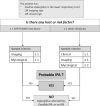New clinical algorithm including fungal biomarkers to better diagnose probable invasive pulmonary aspergillosis in ICU
- PMID: 33683480
- PMCID: PMC7938267
- DOI: 10.1186/s13613-021-00827-3
New clinical algorithm including fungal biomarkers to better diagnose probable invasive pulmonary aspergillosis in ICU
Abstract
Background: The classification of invasive pulmonary aspergillosis (IPA) issued by the European Organization for the Research and Treatment of Cancer/Mycoses Study Group Education and Research Consortium (EORTC/MSGERC) is used for immunocompromised patients. An alternative algorithm adapted to the intensive care unit (ICU) population has been proposed (AspICU), but this algorithm did not include microbial biomarkers such as the galactomannan antigen and the Aspergillus quantitative PCR. The objective of the present pilot study was to evaluate a new algorithm that includes fungal biomarkers (BM-AspICU) for the diagnosis of probable IPA in an ICU population.
Patients and methods: Data from 35 patients with pathology-proven IPA according to European Organization for the Research and Treatment of Cancer/Mycosis Study Group (EORTC/MSGERC)-2008 criteria were extracted from the French multicenter database of the Invasive Fungal Infections Surveillance Network (RESSIF). The patients were investigated according to the AspICU algorithm, and the BM-AspICU algorithm in analyzing the clinical, imaging, and biomarker data available in the records, without taking into account the pathology findings.
Results: Eight patients had to be excluded because no imaging data were recorded in the database. Among the 27 proven IPAs with complete data, 16 would have been considered as putative IPA with the AspICU algorithm and 24 would have been considered as probable IPA using the new algorithm BM-AspICU. Seven out of the 8 patients with probable BM-AspICU IPA (and not classified with the AspICU algorithm) had no host factors and no Aspergillus-positive broncho-alveolar lavage fluid (BALF) culture. Three patients were non-classifiable with any of the two algorithms, because they did not have any microbial criteria during the course of the infection, and diagnosis of proven aspergillosis was done using autopsy samples.
Conclusion: Inclusion of biomarkers could be effective to identify probable IPA in the ICU population. A prospective study is needed to validate the routine application of the BM-AspICU algorithm in the ICU population.
Keywords: Aspergillus qPCR; Clinical algorithm; Fungal biomarkers; Galactomannan antigen; Intensive care unit; Invasive aspergillosis.
Conflict of interest statement
The authors have disclosed that they do not have any potential conflicts of interests.
Figures
Similar articles
-
Impact of revised EORTC/MSGERC 2020 criteria on diagnosis and prognosis of invasive pulmonary aspergillosis in patients with hematological malignancies undergoing bronchoscopy.J Mycol Med. 2022 Nov;32(4):101304. doi: 10.1016/j.mycmed.2022.101304. Epub 2022 Jun 15. J Mycol Med. 2022. PMID: 35738036
-
Invasive pulmonary aspergillosis in solid-organ transplant patients in the intensive care unit.Transpl Infect Dis. 2022 Feb;24(1):e13746. doi: 10.1111/tid.13746. Epub 2021 Dec 14. Transpl Infect Dis. 2022. PMID: 34843161
-
A Comparison of Diagnostic Criteria for Invasive Pulmonary Aspergillosis in Critically Ill Patients.Infect Dis Ther. 2023 Jun;12(6):1641-1653. doi: 10.1007/s40121-023-00818-w. Epub 2023 May 18. Infect Dis Ther. 2023. PMID: 37199881 Free PMC article.
-
Invasive pulmonary aspergillosis in the COVID-19 era: An expected new entity.Mycoses. 2021 Feb;64(2):132-143. doi: 10.1111/myc.13213. Epub 2020 Nov 29. Mycoses. 2021. PMID: 33210776 Free PMC article. Review.
-
COVID-19-Associated Pulmonary Aspergillosis (CAPA).J Intensive Med. 2021 Aug 7;1(2):71-80. doi: 10.1016/j.jointm.2021.07.001. eCollection 2021 Oct. J Intensive Med. 2021. PMID: 36785564 Free PMC article. Review.
Cited by
-
An Observational Cohort Study of Bronchoalveolar Lavage Fluid Galactomannan and Aspergillus Culture Positivity in Patients Requiring Mechanical Ventilation.Open Forum Infect Dis. 2025 Feb 15;12(3):ofaf090. doi: 10.1093/ofid/ofaf090. eCollection 2025 Mar. Open Forum Infect Dis. 2025. PMID: 40046892 Free PMC article.
-
Fungi identified via next-generation sequencing in bronchoalveolar lavage fluid among patients with COVID-19: a retrospective study.Eur J Med Res. 2024 Sep 17;29(1):463. doi: 10.1186/s40001-024-02054-5. Eur J Med Res. 2024. PMID: 39289769 Free PMC article.
-
Severe Recurrent COVID-Associated Pulmonary Aspergillosis: A Challenging Case.Healthcare (Basel). 2022 Dec 8;10(12):2483. doi: 10.3390/healthcare10122483. Healthcare (Basel). 2022. PMID: 36554008 Free PMC article.
-
Prediction of pulmonary aspergillosis in patients with ventilator-associated pneumonia.Ann Intensive Care. 2023 Nov 7;13(1):109. doi: 10.1186/s13613-023-01199-6. Ann Intensive Care. 2023. PMID: 37935890 Free PMC article.
-
Invasive Aspergillosis in the Intensive Care Unit.J Fungi (Basel). 2025 Jan 17;11(1):70. doi: 10.3390/jof11010070. J Fungi (Basel). 2025. PMID: 39852489 Free PMC article. Review.
References
-
- De Pauw B, Walsh TJ, Donnelly JP, et al. Revised definitions of invasive fungal disease from the European Organization for Research and Treatment of Cancer/Invasive Fungal Infections Cooperative Group and the National Institute of Allergy and Infectious Diseases Mycoses Study Group (EORTC/MSG) Consensus Group. Clin Infect Dis. 2008;46(12):1813–1821. doi: 10.1086/588660. - DOI - PMC - PubMed
LinkOut - more resources
Full Text Sources
Other Literature Sources


